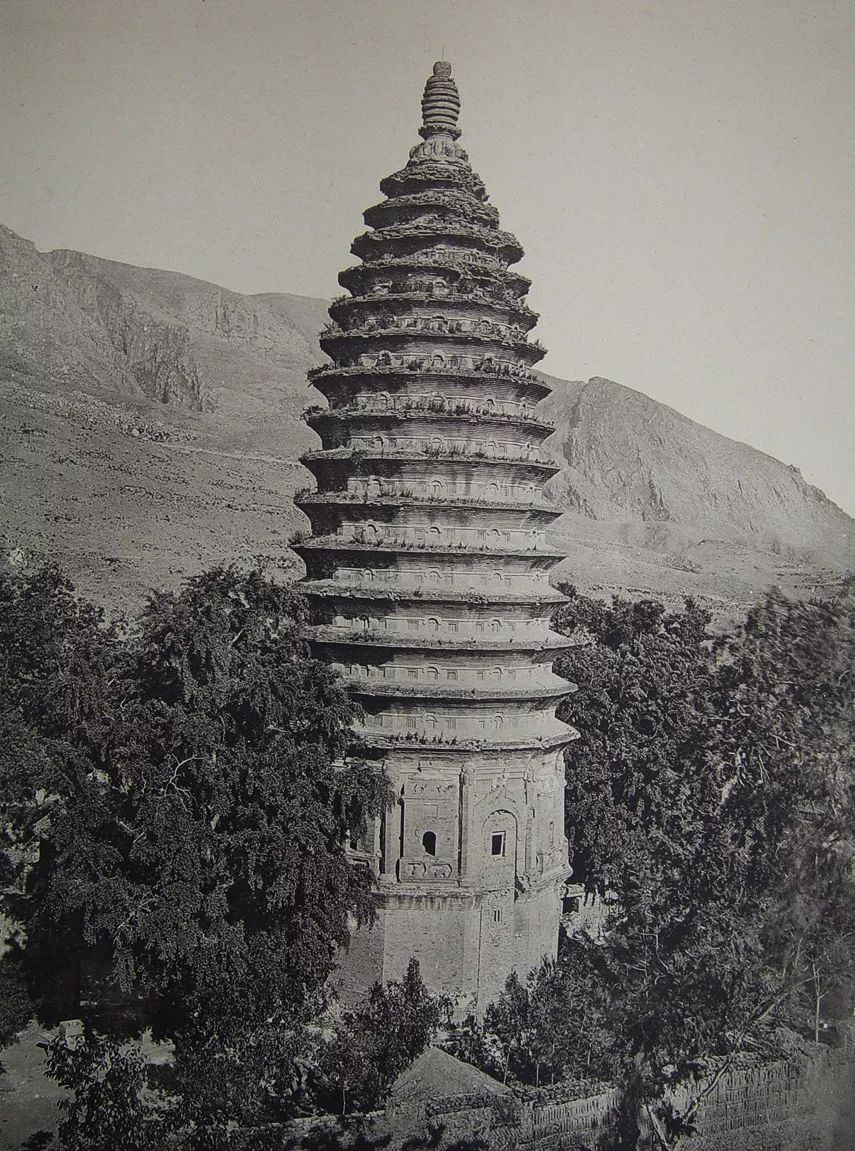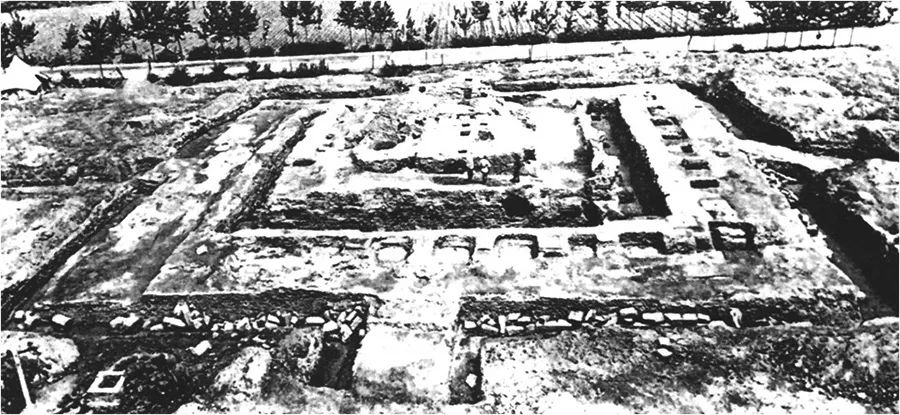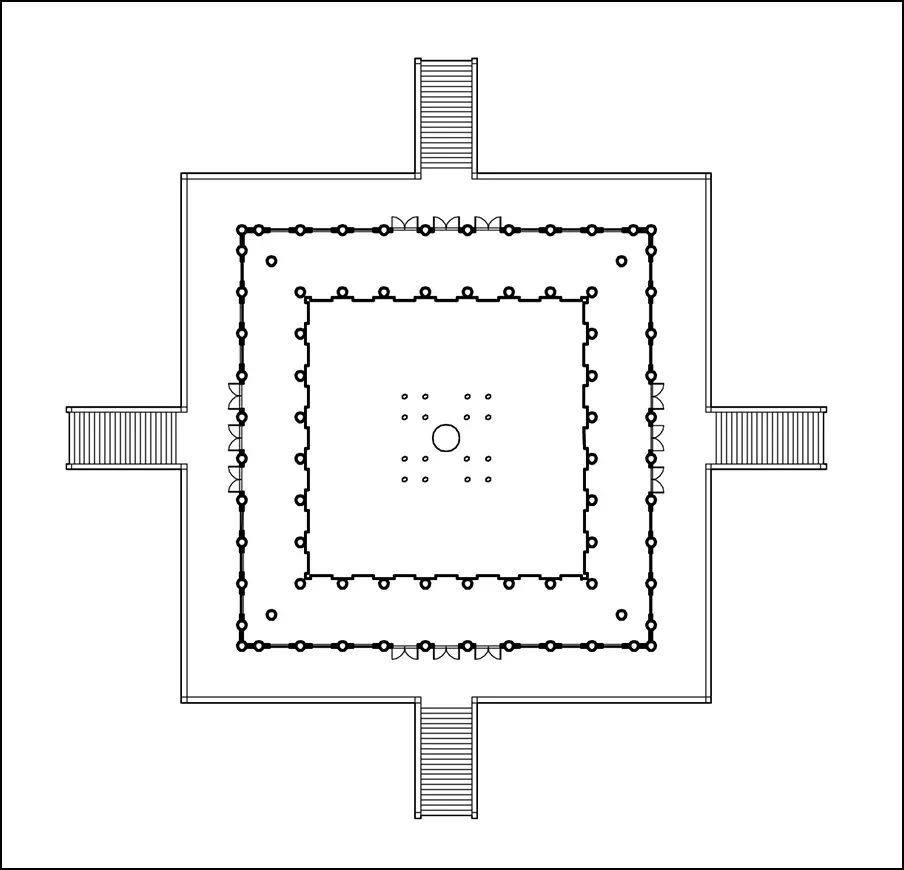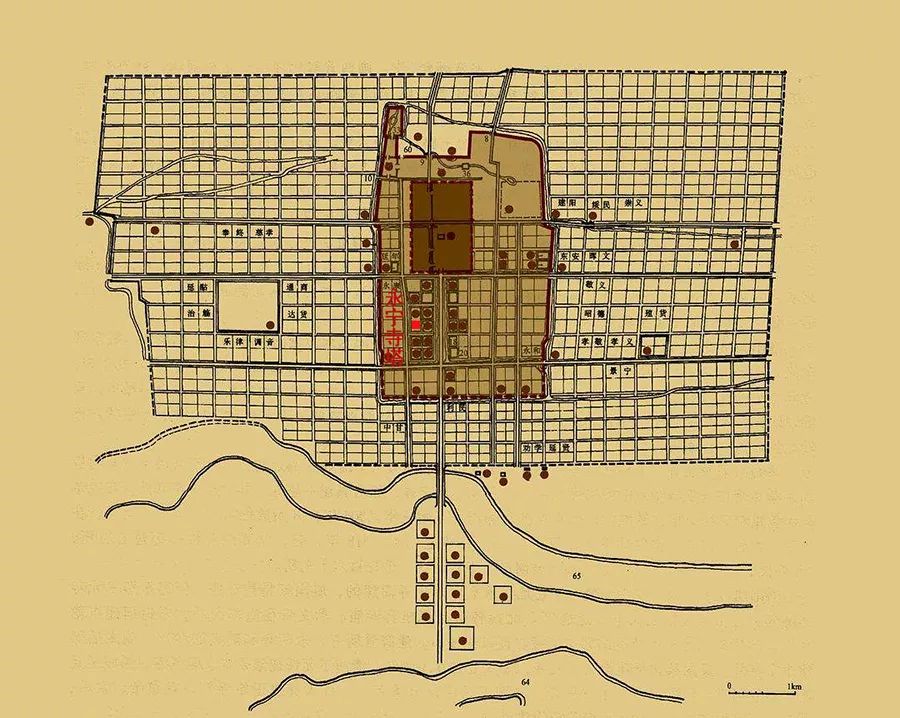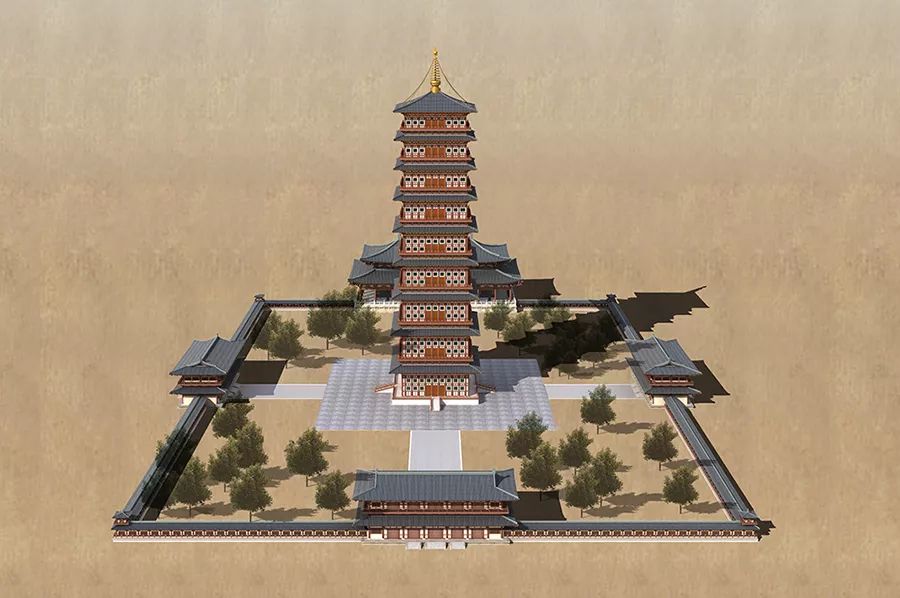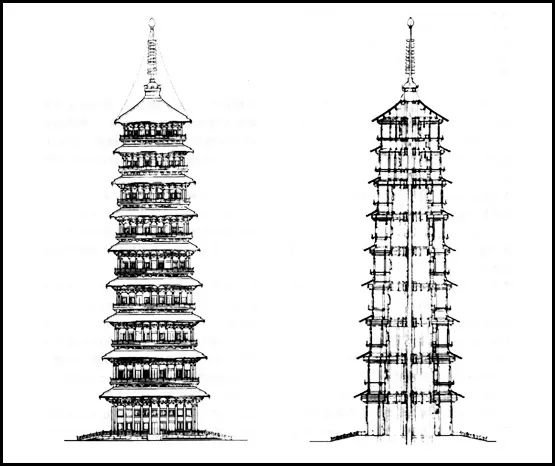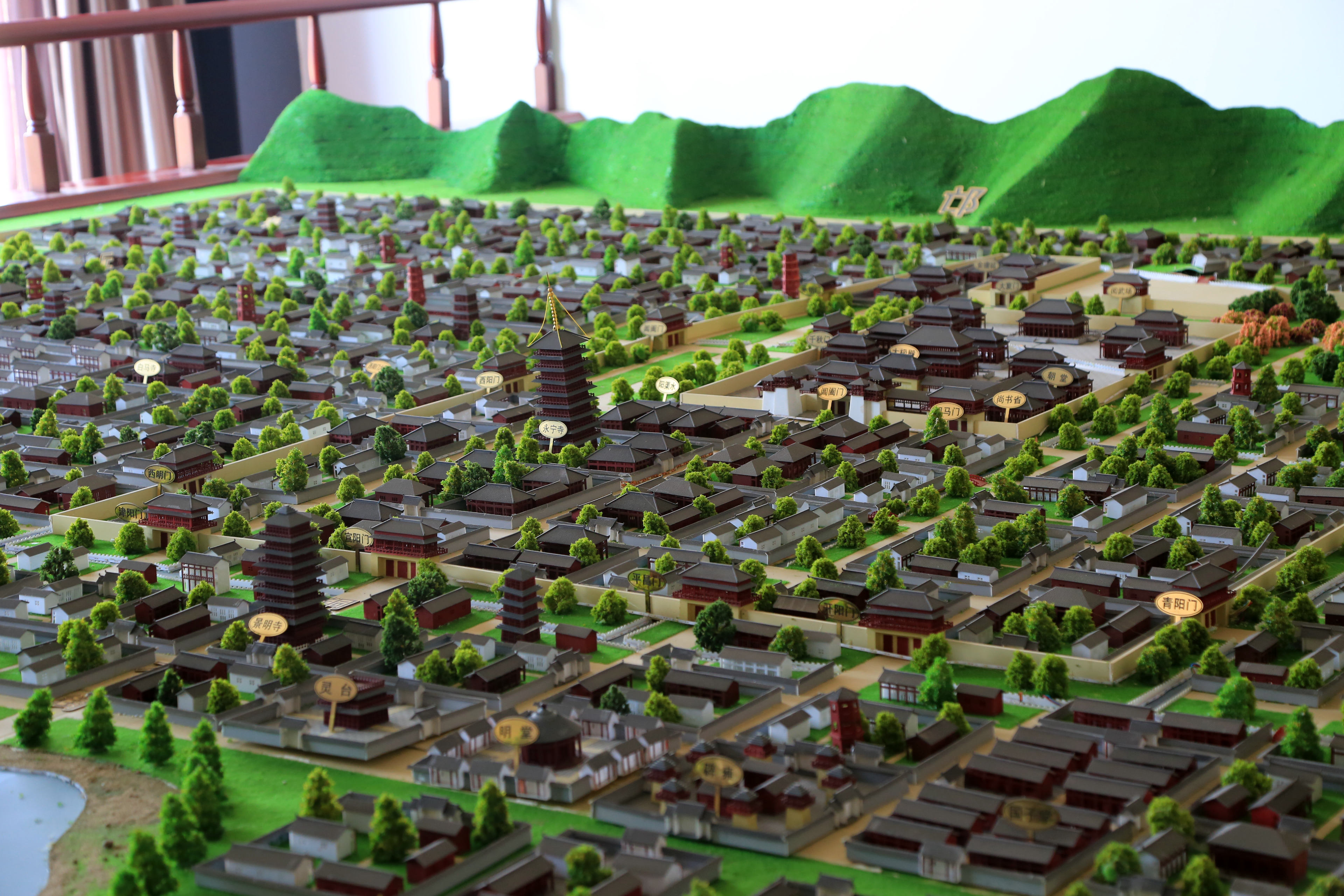DepthReading
One millennium ago in Luo-yang, a disastrous fire burnt down the once highest pagoda in Chinese history
The nine storied pagoda had nine bays on each side with the
middle three opened as do ors and the rest six as w indows. A
circle of flat seat railing were set at the periphery of each floor
which could be used for sightseeing. Doors were painted with
vermilion paint and decorated with five rows of golden nails and
a monster heads hold a golden ring in mouth as door-knocker .
The top of the pagoda were fixed to the four corners of the roo f
eaves of the ninth floor with four iron chains. The vase shaped
spire which could hold 25 Dan ( 1 Dan is about 100 litre) grains
was set on a huge overlapping gold plate. Stone jar shaped gold
bells were hanging on the cornice of end eaves on each of the
nine stories, jingling to a few kilometers away with wind.Classical
sources had various records of the pagoda’ s height. In the
Luo-yang qielan ji (A Record of Buddhist Monasteries in
Luoyang) by Yang Xuan-zhi, the pagoda’ s main body raised 90
Zhangs ( 1 Zhang is about 3.3 meters), and the spire was about
10 Zhangs, so the total height was about over 100 Zhangs (over
272 meters). Li D ao-yuan documented in his S hui-jing zhu
(Commentary on the Water Classic), the pagoda was 49 Zhangs
without the spire, while Wei Shou’ s Wei shu recorded a height of
‘over 40 Zhangs.’
After careful research, nowadays scholars believed that the
saying of " Luo-yang qie-lan ji (A Record of Buddhist Monasteries
in Luoyang)" was over exaggerated, while records in the
Shui-jing zhu (Commentary on the Water Classic) and Wei-shu
(Historical Records of the Wei) were more reliable, suggested
the pagoda was about 150 meters high. This was a miracle
wooden structures considering the pagoda’ s construction date
back to 1000 years ago. E ven among those stone vaulted bell
towers of European Gothic churches which were built between
12-14 centuries, only eight surpass the height of 150 meters. I n
comparison to the tallest one, the German Church of Ulmer,
which had a height of 161 meters, the wooden Yong-ning pagoda
was not inferior in any respect. Even following the m odern
construction standard, the towe r still was a super hi gh-rise
building that was comparable to modern skyscrapers around the
world.
The temple was surrounded by walls. The southern gate tower
had three stories in a height of 20 Zhangs, resembling the Duan
gate of imperial palaces with its arched gateway decorated with variegated murals. Both the western and the eastern gates
had a two-storied structure, while the northern gate was a
black lintelstyle shaped in memorial gate. Outsi de of each
gate there grew locust trees dotted with green streams. the
main hall was located to the north of the pagoda, and adopted
exactly the regulation of the Hall of Supreme in the imperial
palace. Within the main hall, consecrated a Buddha statue tall
in 1.8 Zhangs as well as another ten golden, two jade Buddha
statues, and three embroidered, five golden silk woven
Buddha statues, all of them renowned at the time for their
excellent workmanship. There were ov er 1000 monastic
rooms surrounded by fragrant grassland and forests of
elegant pines, cypresses, and bamboos. The official of
Zhongshusheng(Chancery), Chang Jing, once dedicated in an
hymn for the Yong-ning temple, praising its unprecedented
splendor even over the Sumeru Hall and Tushita Heaven in
Buddhist scriptures.
The most striking view still would be the nine-storied pagoda.
As tall as touching the cloud, it became the most remarkable
landmark of Luo-yang. It was even could be seen over 100 li
(1 Li is about 0.5k m) from the c apital city. Standing on the
tower, everywhere of the imperial palace was within ones panoramic
view. Thus the court even issued special regulations
that forbid the ordinaries to climb the pagoda.
It was recorded that Patriarch Bodhi Dharma once visited the
pagoda, with his palms clasped and chanted “namo” , he said
that even during his trips to numerous kingdoms in his over
150 years life, he had never seen any building in such a
splendor. Not any Buddhist temples or pagodas were com -
pared to this one’s gorgeous look. It was beyond any imagination
on the mundane.
Revolt
Although the Empress Dowager Hu seized the power and
administrated the kingdom in good order, although she was
good at poem and archery, as a young widow, her private life
was indecent. She forced her brother-in-law,Yuan-yi, king of
Qing-he, as her lovers. The affair even spread out of the court.
July of the First year of the Zheng-guang reign (520 CE), the
military officer Yuan Cha and the palace officer Liu Teng had
initiated a political rebel and controlled the court soon after.
They invited Emperor Xiao-ming to hold court in the Xian-yang
Palace, while imprisoned the Empress Dowager Hu in the
Northern Palace after they killed Yuan Yi. At the same time, the
Empress Dowager Hu’s nephews, Commander Hu Seng-jing
and the imperial guard Zhang Xhwqu, the Left Genreignl Xi
Kang-sheng wanted to save the Empress Dowager Hu, but
failed.
February of the Fourth year of the Zheng-guang reign (523), as
the died of Liu Teng, Empress Dowager Hu took the chance
and returned to the court with the help of Yuan Yong, king of
Gaoyang, she removed Yuan Cha from his position. She granted an amnesty right after, however, abandoned the court
administration and more indulgent in her private life. She became
more notorious after having an affair with her minion Zheng Yan.
Once in an imperial gathering, Hu Seng-jing complained tearfully
for her extravagant indulgence. Dowager Hu was irritated and
refused to see him since then. Living an extremely luxurious life,
Empress Dowager Hu frequently rewarded her minions with large
amount of treasures. It further boosted a corrupted living style
among the bigwigs, the whole country was out of order. The
ordinaries were living in poor and struggling in the end of the
world.
Northern Wei had assigned six forts on the northern frontier,
including Wo-ye, Huai-shuo, Wu-chuan, Fu-ming, and Rou-xuan
which were guarded by hereditary generals. Along with the
corruption in court and the deterioration of economy, life of
soldiers and civilians of the six forts became worse and worse,
finally burned out mass rebellions that followed by minority ethnic
groups in Guan-long and He-bei. Meanwhile Roulan invaded from
north and the Liang kingdom from the south. The state soon fell
into chaos.
In the Second year of the Xiao-chang reign (526 AD), Luo-yang
suffered a strong gale, with building roofs were blown away and
even huge trees were pull off. The precious vase shaped spire of
the Yong-ning tower were destroyed and fell into the earth more
than one Zhang. Although it liked an auspicious warning, the
Empress Dowager Hu did not consider it seriously, just let the
craftsmen made a new one and fixed back.
As the Emperor Xiao-ming grew up the young emperor wanted to
control the country himself. In addition, his hatred of his mother’s
indulgence further broadened the gap between them.
January the First year of the Wu-tai reign (528 AD) in the lunar
calendar, Emperor Xiao-ming’s concubine Pan born a daughter
but Empress Dowager Hu announced the baby as a prince and
held extravagant celebrations. Her purpose was to replace
Emperor Xiao-ming with the new ‘prince.’ Emperor Xiao-ming
issued a secret order to Er-zhu Rong, the chieftain of Qihu led his
army to the capital for protecting him and forcing the Empress
Dowager to abdicate.
Furious at the information, Empress Dowager poisoned the
Emperor Xiao-ming with the help of Zheng Yan and Xu He, and
enthroned the newly born infant. She then changed the imperial
order the day of enthronement, gave the crown to a two-year-old
boy, Yuan Zhao, a son of Lin-tao king, Yuan Bao-hui.
Noticed about Xiao-ming’s death, Er-zhu Rong proclaimed that
he’s going to revenge for Xiao-ming and sped up his march
towards the capital. Collaborated with Yuan Tian-mu, the
commander of Bing-zhou, they invited king Chang-le Yuan Zi-you
to Heyang as the new emperor. Er-zhu Rong’s army crossed the
yellow river at Mengjin, and defeated Empress Dowager Hu army
at Luoyang.
5 A massive annihilation
Er-zhu Rong’s army occupied Luo-yang immediately after the
battle. Empress Dowager Hu ordered all the concubines followed
her as nuns in the Yong-ning temple to save their lives.
However, the Yong-ning temple could not protect her. Er zhurong
pretended to sacrifice the heaven, and gathered all officials at
Yuanziyou Palace on the South Bank of the Yellow River then
killed more than 2000 officers. In the same day, his cavalry
arrested Dowager Hu and the infant emperor Yuan Zhao, and
drown them into the torrent Yellow River. History named the day ‘Crisis on south side of the river.’ Including the Minister Yuan
Yong, king of Gao-yang, the Commander Yuan Qin, and Yuan
Lv, king of Yi-yang, the imperial family of Luo-yang and other
noble clans were since then exterminated. Er-zhu R ong
seized all the power and proclaimed himself as the Shi-zhong,
the Grand Genreignl, and king of Tai-yuan, even to covet the
throne. He ordered to made a golden statue of himself to predict
luck four times but all were failed. He suspended his plan
and greeted Yuan Zi-you as the new Emperor Xiao-zhuang,
he led his troops back to Jin-yang, but still remoted the king -
dom under his control.
In succeeding years, Er-zhu Rong achieved a peak of power
and became the Grand Minister after he conquer ed large
lands in He-bei and Guan-long, and defeated Chen Qing-zhi,
commander of the Ling kingdom.
In the Third year of the Yong-an reign (530 AD), Er-zhu Rong
went back to the capital, preparing for usurping the throne.
with help of other officials, Emperor Xiao-zhuang ambushed
traps in the Ming-guang H all before hand and slew Er-zhu
Rong with swords.
Er-zhu Rong’ s nephew Er-zhu Zhao and Er-zhu Du-lv, and
his cousin Er-zhu Shi-long led army swayed in Luo-yang. All
the palace guardians ran away. The Emperor Xiao-zhuang
was caught by cavalry and captured in the Yong-ning temple
and later escorted to Jin-yang, eventually was be killed in the
Wu-ji temple. After several meetings chiefs of the Er-zhu clan
enthroned Yuan Ye, king of Chang-guang as the new
emperor, then reset Yuan Gong, king of Guang-ling as the
e m p e r o r. E r - z h u Z h a o s e l f - c l a i m e d a s t h e c h i e f
commander,connived his troops killed princes, insulted concubines,
and burning, killing and looting recklessly. Luo-yang
was soon turned into a hell on earth. Later, followed the way
how Er-zhu Rong performed, Er-zhu Zhao ultimately returned
to Jin-yang for guard.
As the Er-zhu clan irritated resentment tremendously, Er-zhu
Rong’ s genreignl Gao Huan took the chance to rise power.
Gao initiated an expedition against the Er-zhu clan, and
enthroned Yuan Lang, king of An-ding. After taking fierce
battles, Gao Huan defeated the Er-zhus and soon occupied
Luo-yang. He enthroned Yuan Xiu, king of Ping-yang, known
as Xiao-wu, the last emperor of the Northern Wei. Both Yuan
Gong and Yuan Lang, were be killed. Gao Huan became the
new minister in control of the court but remained his stay in
Jin-yang.
Almost pirate of the history of Eastern Han’ s last decades,
Er-zhu Rong reminds people of Dong Zhuo, Er-zhu Zhao
resembles Li Jue and Guo Si, while Gao Huan relived as Cao
Cao. The several puppet emperors have the same destiny as
Liu Bian, the Emperor Shao of the Eastern Han, and Liu Xie,
the Emperor Xian, with their lives and deaths controlled in
others’ hands and ended up in a misreignble fate.
6 The Burning Down
Interested in martial arts, Yuan Xiu, the Emperor Xiao-wu was
known for some courage, and therefore was not willing to be
manipulated by Gao Huan. He secretly plans for a strike back,
however, it is bound to fall in view of the doomed destiny of the
Northern Wei.
In February of the Third Year of the Yong-xi reign (534 AD), the
Pagoda of the Yong-ning temple suddenly fell into fire unreasonable.
The fire started from the eight level, spread upwards and downwards in the dawn. The pagoda was swallowed by big
fires right after.
After inspecting the fire from the Ling-yun Terrace, Emperor
Xiao-wu dispatched Yuan B ao-ju, king of Nan-yang, and
Zhang-sun Zhi, chief of palace guards, to save the fire with
thousand soldiers. The fire was irreversible when they arrived,
soldiers could did nothing but left with mourning in deeply
sorrow. As fire was turning dark , thunder storm arrived with
snow. It was as if the heaven was seeing the pagoda off.
Regardless of monastics or laymen, all people in the city came to
watch the fire, with their cries loud enough to shake the earth .
Three monks even immolated themselves into the fire to perform
sacrifice for the pagoda.
The fire had lasted for over three months, with smoke still
spreading out even one year later . From its completion to its
demolish, this pagoda lasts merely for fifteen years, yet
witnessed the last reign of the Northern Wei from its prosperity to
its complete collapse.
Someone from Dong-lai prefecture arrived at Luo-yang in May,
said that he once saw the pagoda in the sea, with rays of light s
shining over alike new one, but disappeared along in the air.
In July, Emperor Xiao-wu decided to break with Gao Huan. He
brought a large group of of ficials and nobles left Luo-yang
secretly, and fled to Chang’ an for protection of another warlord,
Yu-wen Tai. After heard the news, Gao Huan marched to
Luo-yang and stayed temporarily in the Yong-ning temple. He
dispatched army to catch Xiao-wu but failed. In October , Gao
Huan abolished Xiao-wu’ s title for his leave, and enthroned Yuan
Shan-jian, the eldest son of Qing-he king. Right after they moved
the capital to Ye city and dismantled palaces in Luo-yang for
delivered the materials to construct new palaces in Ye city.
In December, Yu-wen Tai killed the Emperor Xiao-wu with poison
in Chang’ an. Yuan Bao-ju, the king of Nan-yang, became the
new emperor. Northern Wei, which has once dominated the
north for over a hundred years officially split into two new political
groups, the Eastern Wei and the W estern Wei. History thus
turned to a brand new page. Underwent fights of the two new
Wei kingdoms, Luo-yang city was destroyed devastatingly.
In the Fifth year of the Wu-ding reign (547 AD) of Eastern Wei,
minister Yang Xuan-zhi went to Luo-yang for business. He saw
nothing but ruins of the once pr osperous metropolitan. The
Yong-ning temple left nothing but foundations and broken walls.
With great emotion, Yang Xuan-zhi devoted himself t o five
volumes works named Luo-yang qie-lan ji (A Records of the
Buddhist Monas teries in Luo-yang). He pondered on the
vicissitude of the lost kingdom by recording the construction and
devastation of Buddhist monasteries in Luo-yang. Elegantly
written and supported by accurate historical data, this book was
considered one of the three classic w orks of the N orthern
Dynasties, together with Li Dao-yuan’ s Shui-jing zhu
(Commentary on the W ater Classic) and Jia Si-xie’ s
Qi-min-yao-shu (The Manual of Important Arts for the People).
Yang Xuan-zhi sadly pointed out in his work that one of the key
factor for the rapid decline of the N orthern Wei was that the
imperial family and noble’ s excessive indulgence in Buddhist
activities, and their ignorance of the people’ s welfare. They
regardless the suffering of people but spent large amount of
money to construct monasteries and pagodas, the main halls of
which became even comparable to the E-pang Palace of the Qin
Dynasty, and pagodas of which were even taller than the
auspicious terraces of the remote ancient in the past. Rendered
the Pagoda of the Yong-ning temple in great details, the book
considered it as the highest symbol of the reign.
Yongning Temple Pagoda was not only the highest Pagoda in
the north and South Dynasties, but also probably the highest
Pagoda in Chinese history. Shiga pagoda of Yingxian county of
Fogong temple in Shanxi Province, was the only existing pure
wood ancient pagoda in China. It was built in the second year
of Qingning (1056AD) of Liao Dynasty, more than five hundred
years later than Yongning pagoda. The Yingxian wood tower
was magnificent and praised by later generations, but its 67.31
meter height was just less than half of Yongning pagoda.
From 1979 to 1981, the Institute of Archaeology of the Chinese
Academy of Sciences excavated at Yong-ning temple and
found the pagoda’s foundation survived basic complete, even
with locations of column pits left clearly, enough to mutual
proof with the records in Luo-yang qie-lan ji (A Record of
Buddhist Monasteries in Luoyang)and Shui-jing zhu
(Commentary on the Water Classic). According to relevant
materials, several architectural historians tried to reappear the
original appearance of Yong-ning Pagoda after research, in
order to help us understanding the peerless beauty of this
miraculous pagoda of the past.
Category: English
DepthReading
Key words:Yongning,Pagoda

